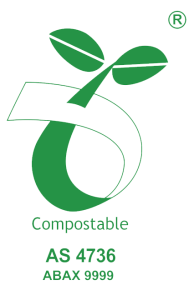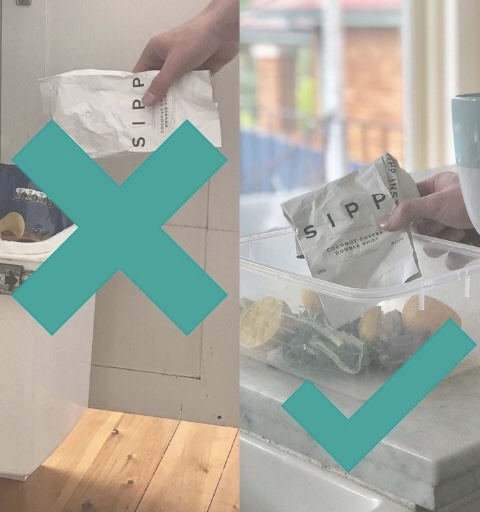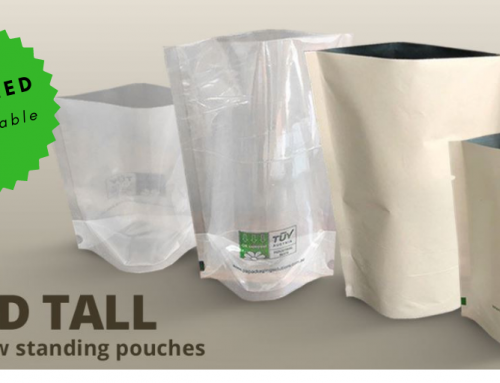When you search for the keyword ‘home compostable packaging’ in Google, results show companies and websites that produce compostable packaging.
This seemingly small difference can have a serious effect on the outcome of the packaging’s future and for our environment.
There is a significant difference between the two products and this is where the confusion begins.
The Australian Institute of Packaging (AIP), the peak professional body for packaging education and training in Australasia is concerned about this situation.
Dr Carol Kilcullen-Lawrence, the National President of the AIP commented in an article in Foodmag, ‘In light of the recent Australian Environment Ministers announcement that 100 per cent of packaging in Australia will be reusable, recyclable or compostable by 2025 we need to better understand how we can really achieve this and how different this target is compared to the packaging waste streams that are in place today. The first step is to understand the difference between compostable (including home compostable) and biodegradable packaging’
This is concerning for the food and product industry looking for truly sustainable packaging or environmentally friendly solutions to improving their business’ impact on the environment.
It isn’t easy finding eco friendly packaging
As consumers become more aware of the devastating effects of plastic on the environment, they are demanding companies reduce their plastic and seek environmentally friendly and sustainable packaging.
With innovation and technology developing, packaging companies are producing eco friendly packaging alternatives such as compostable bags and home compostable packaging. However, as business owners and consumers we need to be conscious of the type of packaging we are purchasing and that we can be certain of its end of life cycle.
What is compostable packaging?
Compostable packaging refers to the ability of the packaging to biologically decompose and disintegrate in a commercial composting facility only. The composting process must be at set levels and within a defined period of time.
Industrial composting facilities treat the packaging with high temperatures (over 55 degrees, much higher than can be achieved in the backyard) to encourage the breakdown of the material where it will become organic rich soil that can be on sold.
To be classified as compostable packaging, the packaging must also meet specific quality criteria relating to its ecotoxicity and other characteristics.
Compostable packaging and the environment
Compostable packaging does reduce the environmental impact at end-of-life, if the packaging was placed in industrial composting facilities.
However, in Australia, there are currently only 150 of these commercial composting facilities and most are not located close to cities. This lack of services means that not all packaging placed in recycling bins will go to these facilities.
Some local councils have practices in place for food waste and packaging to be composted. Currently, South Australia is the only state that allows for kerbside collection of compostable packaging and food scraps. Local SA councils provide a bin liner for residents to use the green bin for industrial composting.
A few councils in Northern NSW (Ballina and Lismore) have the same facilities as South Australia with some other councils talking about it or in planning stages.
Australian standards in compostable packaging
In Australia, the Australasian Bioplastics Association (ABA) is the governing body that sets and provide the standards for packaging based on its level of biodegradability. When packaging is classified as compostable, and has undergone stringent testing set by the ABA, the packaging is accredited the Australian Standard AS 4736-2006.
The Australian Standard AS 4736–2006
Using the ‘seedling logo’ certification system throughout Australia and New Zealand, consumers can now clearly identify and differentiate packaging materials as biodegradable and compostable.
 This standard covers companies and individuals wishing to verify their claims of conformance to biodegradable plastics suitable for industrial composting. To be certified compostable and carry the seedling logo, suitable biopolymer materials must undergo a stringent test regime outlined by AS4736 and carried out by recognised independent accredited laboratories to the AS4736 standard.
This standard covers companies and individuals wishing to verify their claims of conformance to biodegradable plastics suitable for industrial composting. To be certified compostable and carry the seedling logo, suitable biopolymer materials must undergo a stringent test regime outlined by AS4736 and carried out by recognised independent accredited laboratories to the AS4736 standard.
As more communities introduce source separation systems for diverting food waste from landfill, having certified compostable packaging available that are 100% biodegradable in industrial composting will give consumers and organic waste processors such as composters, the assurance that the products will completely biodegrade in efficiently run systems.
Home compostable packaging

The decomposing of home compostable packaging
If food or other packaging is labelled home compostable, then it can be placed in a home compost bin, or the green bins where it will decompose and become organic rich soil, within a measured period of time.
Packaging that is home compostable should mean that every component and material used in the packaging will breakdown and decompose into organic soil. This includes the whole of the package; the printing ink, and the adhesives used to seal the package.
The Australian Standard for home compostable packaging.
Australian Standard AS 5810-2010
The ABA also sets the standard for home compostable packaging. The Australian Standard AS 5810-2010 covers companies and individuals wishing to verify their claims of conformance to Biodegradable Plastics suitable for home composting. 
Products, bags and packaging that conform to the Home Composting Australian Standard AS 5810-2010, verified by the Australasian Bioplastics Association can be endorsed with the ABA Home Composting logo.
The Home Composting logo ensures that these products and materials are easily recognised, and food waste or organic waste contained in these certified products can be easily separated out and diverted from landfill.
Why you should choose home compostable packaging
Until Australia’s recycling facilities for compostable packaging improves, using this type of packaging how it is meant to be disposed of is still a long way off.
Australian councils need to work on improving access to compostable waste recovery to industrial composting and educate their residents for the disposal of this type of packaging, otherwise compostable packaging will end up in landfill.
Using home compostable packaging allows your consumers to compost the packaging in their home, along with their fruit and vegetable scraps or place it in their green waste bin for composting. This is an environmentally friendly solution available today.
Changing your current food packaging to home compostable has many more benefits for the environment – it is a sustainable product (for every tree cut down another one is planted) and their lighter weight saves costs on transport and energy costs in distribution.
Talk to PA Packaging Solutions today, to see how our home compostable packaging can now be a viable solution to your food brand and product marketing.




